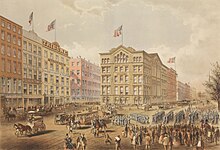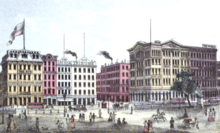Park Row (Manhattan)
Chatham Square |
Park Row is a street located in the
Park Row was once known as Chatham Street; it was renamed Park Row in 1886, a reference to the fact that it faces City Hall Park, the former New York Common.
History
18th century


In the late 18th century Eastern Post Road became the more important road connecting New York City to Albany and New England to its north. This section of the road which became Park Row was called Chatham Street,[1] a name that enters into the city's history on numerous occasions.
The
Chatham Street was also a center for entertainment. In 1798, Marc Isambard Brunel designed the 2,000-seat Park Theater on Chatham Street, intended to attract the upper classes of the city. The theater cost $130,000 to build, and tickets were 25 cents for seats in the gallery, and 50 cents in the orchestra. In the early 1800s, more taverns, theaters and small hotels on the street started to offer free entertain to attract customers to drink. These were called "free and easies", "varieties" or "vaudeville" and offered numerous different kinds of performances: comedy, dance, dramatic skits, magic, music, ventriloquism, and tellers of tall tales. New theaters such as the Chatham Theater sprang up as well to attract the overflow from the entertainment strip on the Bowery.[5] Boxing was also a popular entertainment. The Arena on Park Row packed in fans with its nightly presentation of "the manly art".[6]
19th century
In the early 19th century, most of the Manhattan portion of the street was suppressed, the Commons became
During the late 19th century, Park Row was nicknamed Newspaper Row, as most of New York City's newspapers located on the street to be close to City Hall.[11] Among the earlier newspapers in the area were The New York Times,[12]: 3 which in 1857 became the first New York City newspaper to be housed in a structure built specially for its use.[13] Part of the southern section of the street, centered on the intersection with Spruce Street, was known as Printing House Square. The newspapers housed on Newspaper Row, combined, printed more than 250,000 copies per day at their peak, leading the area to be considered "America's preeminent press center".[14] Other papers, such as the New York Herald and The Sun, were near Newspaper Row but not actually housed on Park Row itself.[14]
The newspapers on Chatham Street were among the first to construct
After the construction of the
The next major structure to open was a new headquarters for The New York Times at 41 Park Row, which was completed in 1889 and stood 13 stories tall.[19][12]: 4 The third early skyscraper on Newspaper Row was the 20-story New York World Building, the New York World's headquarters, which at a height of 309 feet (94 m) was the first building in the city to be taller than Trinity Church.[20] The Times and Tribune Buildings were both expanded in the first decade of the 20th century.[12]: 6 [21]
Two other buildings on Park Row were also part of Newspaper Row but not built specifically for newspapers' use. The Potter Building, at 38 Park Row, contained tenants such as The Press, a Republican Party-affiliated penny paper, as well as The New York Observer.[22] The Park Row Building, at 15 Park Row, housed the early headquarters of the Associated Press, founded by Moses Yale Beach.[23][24]
The Revolution, a newspaper established by women's rights activists Susan B. Anthony and Elizabeth Cady Stanton was also headquartered on Park Row, at 27 Chatham Street.[25]
The decline of Park Row as a newspaper hub began in 1895, when the Herald moved to Herald Square.[14]
20th century
Ten years later, in 1905, the Times moved to its new headquarters at One Times Square.[26] The Tribune moved uptown in 1923,[27] while the World shuttered in 1931.[20] The Journal of Commerce, the last remaining newspaper to publish from Park Row, moved from its headquarters in the World Building in 1953.[28]
Until 1971, Park Row continued in a relatively straight path, except for a curved portion around the Brooklyn Bridge's ramps.
Today, a statue of
Structures
The New York Times was originally located at 113 Nassau Street in 1851. It moved to 138 Nassau Street in 1854, and in 1858 it moved a little more than one block away to 41 Park Row, possibly making it the first newspaper in New York City housed in a building built specifically for its use.[13] The New York Times Building, which was designed by George B. Post, was designated a New York City landmark in 1999.[33] The building is now used by Pace University.[34]
The New Yorker Staats-Zeitung moved to its own building at 17 Chatham Street at almost the same time as the Times moved into its new building.[35][36]
The Park Row Building (also known as 15 Park Row) is located at the western end of Park Row, opposite City Hall Park. Designed by noted architect R. H. Robertson, and built in 1896-99, It was designated a city landmark in 1999.[33] At 391 feet (119 m) tall it was the tallest building in the world from 1899 until 1908, when it was surpassed by the Singer Building.[37]
The Potter Building at 38 Park Row (145 Nassau Street) was built in 1882-86 and designated a New York City landmark in 1996. It was built after the owner's previous building on the site burned down. The Potter Building was converted into apartments between 1979 and 1981.[33]
The New York City Police Department is headquartered at 1 Police Plaza located on Park Row, across the street from the Manhattan Municipal Building[38] and Metropolitan Correctional Center.
Two apartment buildings of significance on Park Row are the Chatham Towers at no. 170, built in 1965 and designed by Kelly & Gruzen, which, according to the AIA Guide to New York City, makes a "strong architectural statement...[which] rouses great admiration and great criticism," and Chatham Green at 185 Park Row, built in 1961 and also designed by Kelly & Gruzen.[39]
Police Plaza closure
The segment of Park Row between Frankfort Street and
In 2007, the NYPD stated that it would not be moving despite the numerous complaints from residents, explaining that they had tried to alleviate the impact of the security measures by forbidding officers from parking in nearby public spaces and by reopening a stairway that skirts the headquarters' south side and leads down to street level near the Brooklyn Bridge. The department also planned to redesign its guard booths and security barriers to make them more attractive, and was involved in efforts to convert two lanes of Park Row into a cycling and pedestrian greenway,[38] which opened in June 2018.[43]
References
Notes
- ^ Staff (June 22, 1893). "Outrages by 'Pullers in'" (PDF). The New York Times. p. 2.
About forty years ago the original Harris Cohen established a second-hand clothing store at the corner of Baxter Street and Park Row (then Chatham Street).
- ^ Burrows & Wallace (1999), p.1046
- ^ Burrows & Wallace (1999), pp.322,424
- ^ Burrows & Wallace (1999), p.360
- ^ Burrows & Wallace (1999), pp.375,404,642
- ^ Burrows & Wallace (1999), p.755
- ISBN 978-0-8147-2712-6.
- ^ Burrows & Wallace (1999), pp.740,749
- ^ Burrows & Wallace (1999), p.890
- ^ Burrows & Wallace (1999), p.1182
- ISSN 0362-4331. Retrieved September 27, 2020.
- ^ a b c "(Former) New York Times Building" (PDF). New York City Landmarks Preservation Commission. March 16, 1999. Retrieved September 27, 2020.
- ^ ISSN 0362-4331. Retrieved July 14, 2020.
- ^ a b c d "Excelsior Steam Power Company Building" (PDF). New York City Landmarks Preservation Commission. December 13, 2016. p. 4. Retrieved September 27, 2020.
- ^ "Fulton–Nassau Historic District" (PDF). National Register of Historic Places, National Park Service. September 7, 2005. Retrieved September 27, 2020.
- ^ "The Tribune's New Home". New-York Tribune. April 10, 1875. pp. 9, 12 – via newspapers.com
 .
.
- ISSN 0362-4331. Retrieved September 22, 2020.
- ISBN 978-0-300-11465-2.
- ISSN 0362-4331. Retrieved July 15, 2020.
- ^ ISBN 978-1-60354-055-1. (Reprinted by Scholarly Press, 1976; often referred to as WPA Guide to New York City.)
- ^ "The Tribune Buildings". New-York Tribune. February 3, 1907. pp. 60, 61, 62, 63 – via newspapers.com
 .
.
- ^ King, M. (1892). King's Handbook of New York City: An Outline History and Description of the American Metropolis. Moses King. p. 778. Retrieved March 24, 2020.
- ^ Beach, Stanley, Archives at Yale, Stanley Yale Beach papers, Number: GEN MSS 802, 1911-1948
- ^ "Park Row Building" (PDF). New York City Landmarks Preservation Commission. June 15, 1999. p. 5. Retrieved September 27, 2020.
- ^ "The Revolution" Lewis & Clark Digital Collections, Aubrey R. Watzek Library, Lewis & Clark College
- ISSN 0362-4331. Retrieved July 17, 2020.
- ^ "Tribune Goes Uptown". Brooklyn Times Union. April 15, 1923. p. 14. Retrieved September 27, 2020 – via newspapers.com
 .
.
- ^ "Last Newspaper Is Moving Out Of Parle Row: The Journal of Commerce' Leaves 'World' Building for Varick St. Quarters". New York Herald Tribune. February 20, 1953. p. 17. Retrieved September 25, 2020 – via ProQuest.
- ISSN 0362-4331. Retrieved May 18, 2020.
- ISSN 0362-4331. Retrieved May 18, 2020.
- ^ "Historical Sign Listings". New York City Department of Parks and Recreation. Retrieved July 14, 2020.
- OCLC 17508421.
- ^ ISBN 978-0-470-28963-1.
- ISBN 978-0-19538-386-7.
- ^ An Epitome of the New-Yorker Staats-Zeitung's Sixty-Five Years of Progress. 1899. Complimentary pamphlet prepared and distributed by the Staats-Zeitung to describe its history and new press capacity. This source indicates that the Staats-Zeitung was publishing from its building on Chatham Street no later than April 1858, and possibly as early as a year prior to that.
- ^ Burrows & Wallace (1999), p.943
- ISSN 0362-4331. Retrieved July 27, 2020.
- ^ ISSN 0362-4331. Retrieved September 24, 2022.
The Police Department says that most of Park Row has to be blocked off to protect its headquarters, called One Police Plaza, against terrorist threats, particularly truck bombs.
- ISBN 978-0-19538-386-7.
- ^ Hogarty, Dave (September 24, 2007). "Park Row Paralysis". Gothamist. Archived from the original on May 21, 2011. Retrieved March 16, 2011.
- ISSN 0362-4331. Retrieved September 24, 2022.
- ISSN 0362-4331. Retrieved September 24, 2022.
- ^ Spivack, Carol (June 22, 2018). "park-row-bike-pedestrian-paths-reopens-after-9-11-closure". patch. Retrieved July 3, 2018.
Bibliography
- ISBN 0-195-11634-8.
External links
- Park Row: A New York Songline – virtual walking tour
